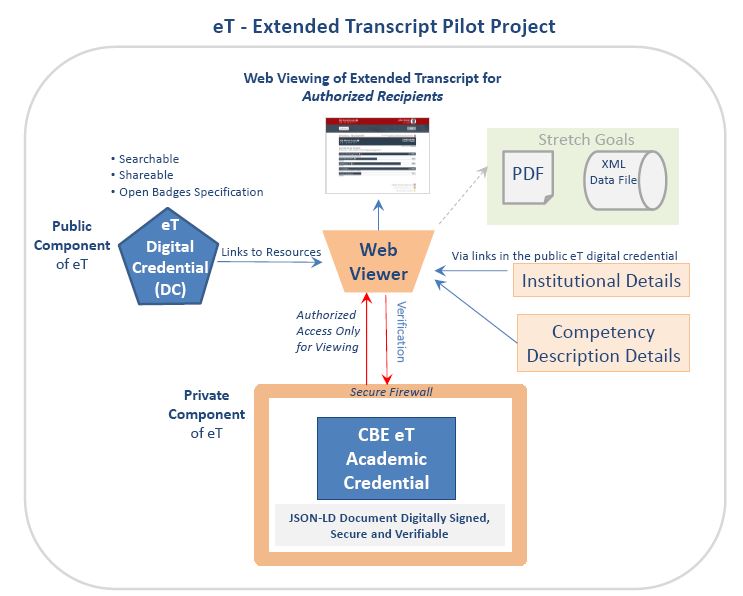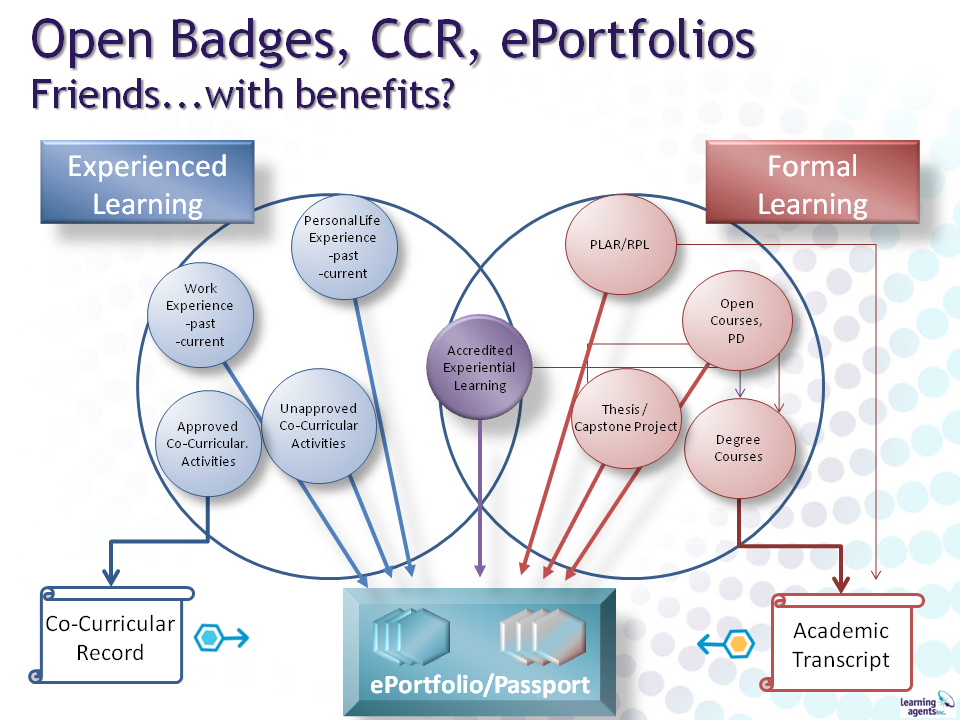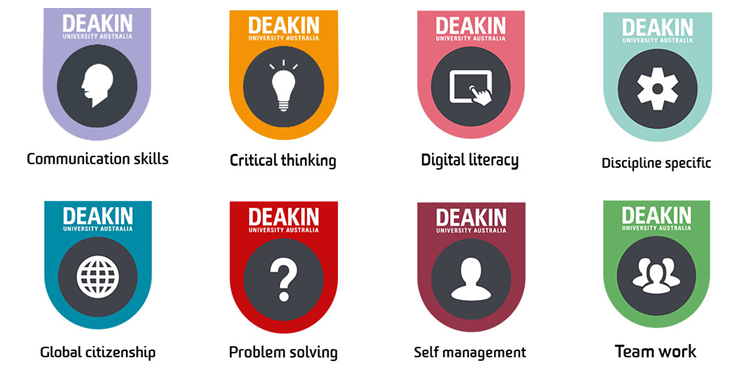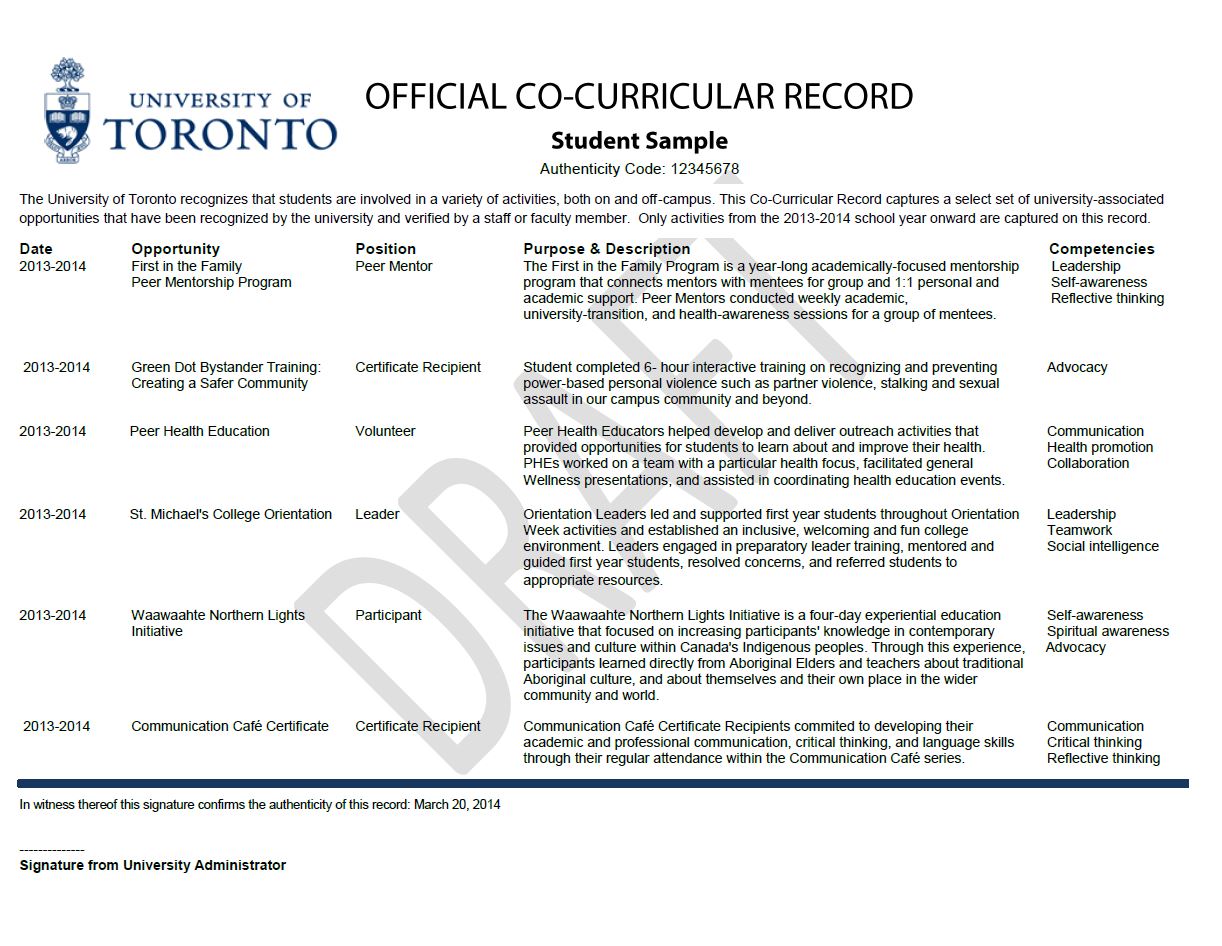This post should interest Higher Education readers in North America, but it may mystify other audiences as much as when I first shared these thoughts in London at ePIC 2014.
But I need to get it off my chest as a companion piece to last week’s discussion about ePortfolios and Open Badges. It’s about the transition from education to work and the employability soft skills that the higher education experience is supposed to foster:
Future posts will explore more actual workforce applications of Open Badges.
What is a Co-Curricular Record (CCR) Anyway?
According to this Masters research study by Kimberly Elias, student life coordinator for campus involvement at the University of Toronto:
The CCR provides a database of activities that allows students to search for opportunities beyond the classroom. Competencies and skills are linked to each activity, which will help students see the connection between their engagement and development. Students will be encouraged to reflect on the competencies and skills gained through their experience. These experiences and competencies are then printed on an official institutional document.
The CCR, also called a Co-Curricular Transcript (CCT), is usually part of campus micro-site portals operating out of Student Services. Campus organizations maintain their own storefronts in these virtual malls, complete with web pages, events management, newsfeeds, social media connections, forums, membership rosters, etc.
In the CCR module, students can find and track participation in campus activities: attendance at events, volunteer hours, etc. Prior to graduation, they can request a comprehensive report which can be endorsed by Student Life.
From the institution’s point of view, it’s a way to demonstrate the learning value of engaged campus life. From the vendor’s point of view, it’s a way to harvest a bit more revenue out of their clients’ engagement with their micro-site technology.
The Promise of Co-Curricular Records
The 2010 video that leads off this playlist goes a little over the top, but other Canadian CCR promos and tutorials in the sequence promise similar benefits:
[youtube https://www.youtube.com/watch?v=videoseries?list=PLxEsMPV549kgB3sma5zVMMtHiZ21TsYu3&w=560&h=315]
Recognizing Learning Outside the Classroom
It’s true that there are many opportunities for informal and non-formal learning. Here’s a list from a Trent University Student Affairs study:
- One-time workshops (ex. attendance at a workshop on academic skills)
- A one-time volunteer commitment (ex. volunteering to lead tours at an Open House)
- A longer-term volunteer commitment (ex. volunteering once per week at the Seasoned Spoon)
- A completed program (ex. completion of the Impact Leadership Program)
- Membership on a team or in an organization (ex. member of campus rec volleyball; member of Trent Penpal Program)
- A leadership position within an organization (ex. member of the executive for the Trent University Anthropology Society)
- An award (ex. Otonabee College Athlete of the Year)
However, I do believe this is a better fit for young, full time “serial students” who lack work experience than for older students resuming their education and/or doing it part-time while working. This latter group is growing compared to the former.
One Stop Shop for Engagement
The CCR database itself is a great way to find campus activities. Participation in these increases attachment to the institution and there’s a correlation between this and student success. University of Toronto’s CCR listed over 1,500 activities in its first year and up to 4,000 were awaiting approval in early 2015, according to this recent article.
Attesting to Employability Soft Skills
Check some of them out in this sample CCR used in the Masters study above: Leadership, Self-Awareness, Communication, Critical Thinking… sounds great!
Preparing for Job Interviews
Just like a portfolio, reviewing your CCR can remind you about episodes from your student experience that you can have ready for behavioural interviews when you’re asked: “Tell me about a time when…”
What’s Wrong with Co-Curricular Records?
Another Silo That Still Excludes Lots of Lifewide Learning
- Only activities and organizations approved by the institution (usually at the Senate level), generally on campus
- No academic experiential learning, research (nothing for credit)
- No activities external to the institution: employment, voluntary community service
I think this is about spheres of control within the institution. Co-Curricular Records are usually run out of Student Affairs. Experiential and Work-Integrated Learning (Co-op, Service, Research Partnerships, etc.) is under academic control. But these boxes need not limit creative thinking on the part of administrators.
Further, outside the institution, students may be learning as much or more from experiences such as employment, travel, hobbies, blogging, causes or community service. Maybe they even took a training course, or a MOOC from (gasp!) another provider. Maybe they delivered a course, or mentored somebody, and deserve recognition for that. But who’s going have the time to recognize it? Probably not Student Affairs.
They Can Be Superficial Laundry Lists
Technically speaking, CCRs are just reports from the campus portal database. They report what’s easy to measure, or upload: participation in events, membership, hours of service, etc.
Students are encouraged to register in a CCR in their first year to identify opportunities, track engagement over time, reflect and produce a well-curated picture at the end of their student careers. Some may do this. For many others it’s a batch process at the end of the final year, with minimal reflection, before, during or after submission.
And not all CCRs seem to support reflection. I don’t see it in the example above. In one example I saw that does, the “reflections” were small text fields, more suitable for activity summaries.
Associated competencies (those all important Essential Outcomes or Graduate Learning Outcomes) seem to be keyword clusters based on the above example, either pre-selected by the campus organization or mouse-clicked by the student, with no further explanation or justification.
There’s no provision in CCR systems for supporting evidence that I’ve seen. The record itself is the evidence. As a related issue, there’s no integration with other achievements, either within the CCR or in other systems, such as an LMS.
They’re Published and Shared On… Paper?
This is the part that I really don’t get in 2016: it’s a paper transcript – with “security features” for the signed version, which is “an official institutional document”. All the C20 bureaucracy of the academic transcript with none of the academic credit.
Heck, even academic transcripts are starting to be shared over networks: Digitary for example, or IMS Global’s eTranscript initiative (which has adopted the Open Badges standard, BTW):

How many employers do you think will demand to see a signed affidavit of your co-curricular activities as a student? Well, I can tell you from the employer focus group in the Trent study:
- Minimal interest in the inclusion of an extra document
- Information from a co-curricular record can be integrated into a resume or cover letter instead
- The resume and cover letter are an opportunity to take everything in a student’s portfolio and link it together; the co-curricular record could be one component of such a portfolio
- Rather than adding an extra document to an application, students should use the document as a tool for reviewing their co-curricular experiences and reflecting on what skills/learning achievements were gained from each
I can’t believe it’s still a static piece of paper… yikes. I’d be happy if anybody out there can tell me differently.
How Can We Make Co-Curricular Records Better?
Dreaming in colour? Let’s see.
Open the Silos: Departmental Isolationism and Vendor Lock-in
Let’s find feasible ways to recognize more of the different forms of learning across our lives, both on and off campus. Many CCRs are already often modules of larger systems that also track Work Integrated Learning, but that’s just a bigger silo. Can it connect to your LMS? Your ePortfolio platform? Other institutions?
This is beyond Student Services, the Registrar, even the Senate. It means being ready to work with other stakeholders outside the institution, even recognizing external credentials, or at least allowing them to be mixed in with yours. You can’t own it all.
So let’s not build or rent huge proprietary data silos to try to beat LinkedIn at its own game. (Are you listening, publicly-funded Canadian job-matching websites?)
Let’s think smaller pieces, more loosely joined and working together, sharing information based on common standards:
 Open Badges, ePortolios and Co-Curricular Records from dpresant
Open Badges, ePortolios and Co-Curricular Records from dpresant
Smaller systems that can be part of larger ecosystems: institutions, communities, sectors, regions… Let’s think open talent streams, not proprietary technology pipelines: from K12 to PSE, from PSE to the workplace, between sectors or even between countries. (A future post will further explore the social benefits of open standards and frameworks).
Make Recognition Modular: Achievements = Open Badges
One way to open up silos is to recognize skills and achievements with portable Open Badges that pass as a common eCredential currency between them.
Instead of a static, signed list of achievements published from a vendor’s locked-down system, let’s sign each achievement so that it can stand on its own and be exported and dynamically remixed with other relevant contextual evidence. That’s how Open Badges work: they’re an eCredentialing standard to recognize achievements.
Get Past the Paper, Remix in a Digital Universe
Have an “official” signed document if you must, but why not also leverage the network effect of modular eCredentials built with Open Badges? Curate them in ePortfolios and flexible Badge Passports; align them to goals with other relevant evidence, display them on social media including LinkedIn and make them discoverable across online communities.

Open Badges, ePortolios and Co-Curricular Records from dpresant
thx @kateycoleman for “Friends…”
Options for making your Co-Curricular Record solution compatible with Open Badges and ePortfolios
If you’re still kicking the tires, talk to your prospective vendors about interoperability with ePortfolios and more modular recognition approaches such as Open Badges.
If you’re already committed to a platform:
- Nag your vendor to upgrade the platform to also publish Achievements as Open Badges, either:
- internally, such as in Moodle, Blackboard and WordPress or (even better):
- via API to an external badge issuing platform like Open Badge Factory, Badgr or Credly. This is probably easier for the vendor and will be more stable over time (“smaller pieces…”)
- If your vendor won’t budge (they do often seem to be in charge), consider having students apply for Open Badges separately, based on Achievements in their CCR and other supporting evidence you prescribe, such as in their ePortfolios. This could be a good way of getting them to select, reflect and connect their learning more authentically!
And finally…
Yes, this was long. But I think it’s important to refactor all the sincere effort by so many people in so many institutions who are committed to preparing theirstudents for the world of work.
In particular, I encourage Canada’s newly formed CCR/T Professionals Network to critically analyze these well-intentioned remarks, particularly in the context of the following emergent CCR-related initiatives in the US:
- Pairing Digital Portfolios & Badges to Recognize Informal Learning
G. Alex Ambrose, Ph.D., Professor of Practice & Associate Program Director of the Notre Dame ePortfolio Engagement Program (nDEEP) - Using Digital Badges to Recognize Co-Curricular Learning
Steven Lonn, Asst. Director for Assessment & Evaluation
University of Michigan
…and this alternative approach to demonstrating Graduate Learning Outcomes from Australia, although it’s under academic control:
- Deakin University Hallmarks
Website | Background document
Addendum
I posted this to LinkedIn, where it sparked a conversation about Smart Evidence for Program Learning Outcomes, which is an emerging feature for the open source Mahara ePortfolio.



Pingback: Open Badge eCredentials: Good Business for Higher Ed (Part 1) | Littoraly
Pingback: Open Badge eCredentials: Good Business for Higher Ed (Part 2) | Littoraly